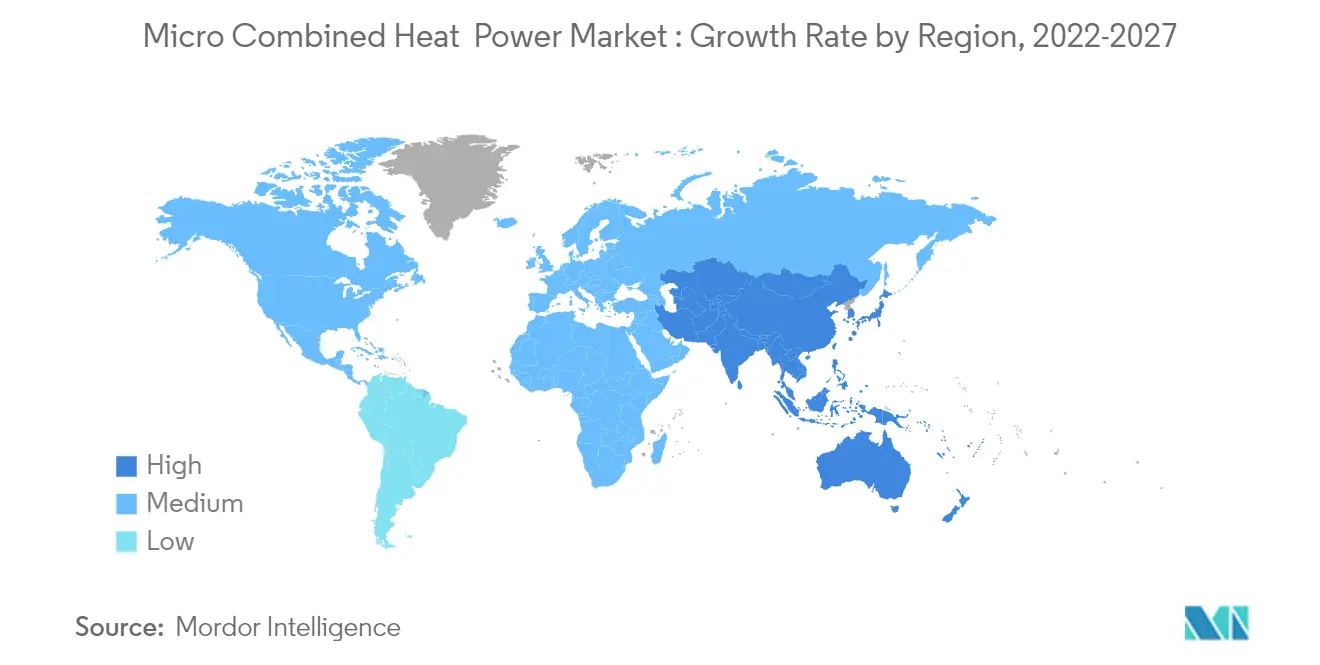Market Trends of Micro Combined Heat & Power (CHP) Industry
This section covers the major market trends shaping the Micro Combined Heat & Power (CHP) Market according to our research experts:
Residential Segment Expected to Dominate the Market
- Due to the smaller size of micro-CHP systems, they provide an effective solution for sectors with relatively lower energy demands, such as domestic households. These systems also can reduce fuel usage, which leads to lower emissions and reduced costs. Smaller micro-CHP systems have high capacity factors (less than or equal to 95%). They can be powered by traditional fuels such as natural gas, liquified petroleum gas (LPG), or oil. They can also be integrated with low-carbon fuels like biogas, renewable natural gas (RNG), hydrogen, or biodiesel.
- Moreover, residential micro-CHP provides a local energy source, which provides an additional layer of resiliency for remote households and communities susceptible to power loss due to grid outages or severe natural disasters.
- One of the main advantages of micro-CHP systems for residential applications is the low space requirement, as these systems are of a similar size and shape to a standard residential boiler system, they can be wall-mounted or placed on the floor. Moreover, though the initial capital outlay for a residential micro-CHP system is greater than that of a similarly-sized steam boiler system, the process and costs of micro-CHP installation are similar. Additionally, maintenance and service costs are equivalent to standard boilers, although the maintenance of micro-CHP systems requires skilled specialists.
- Due to existing natural gas infrastructure for heating, micro-CHP systems have been most successful in high-income countries with cold winters, such as Europe and Japan. In contrast, the market is being driven moderately in other countries such as Canada, the United States, and China over the past few years owing to few pilot projects at residential scale.
- Moreover, United States also offers several federal and state-level incentives in the form of grants, and tax credits, and are eligible for receiving financing from various governmental schemes, in addition to net metering policies for residential micro-CHP users. Though the deployment of residential micro-CHP systems in the country has been limited, the sector has considerable potential. The residential sector consists of 122 million households that require 21% of the nation's total energy consumption. Moreover, as most families depend on traditional systems such as conventional boilers and the grid for their energy, and micro-CHP systems provide an economical, efficient, and resilient alternative.
- Therefore, owing to the above points, residential sector is expected to dominate the micro combined heat & power (CHP) market during the forecast period.

Asia-Pacific Expected to Dominate the Market
- Asia-Pacific is the largest market for micro CHP in the world and is expected to maintain its dominance during the forecast period as well. The region's micro-CHP market is mainly dominated by Japan and few emerging countries, such as China, and South Korea.
- In Japan, fuel cell-based micro-CHP have become a widely preferred form of heat and electricity generation in residential and commercial segments, such as hotels, public facilities, hospitals, Institutions, to incur power savings and for reliable energy supply. The sales of micro-CHP by Ene-Farm program began in 2009 in the country, much ahead of the rest of the world.
- Apart from a shift towards grid-independent power generation, favorable government policies are also a major driver for the adoption of micro-CHP in the country. Foreign Direct Investments and special measure laws for new energy use were implemented to fasten the growth of the CHP market in Japan. Also, in the wake of the Tohoku earthquake and Fukushima nuclear crisis, the Japanese government is promoting the industrial CHP system as safer and cost-effective electricity generation. Hence, these are the major factors driving the micro-CHP market in the country.
- Japan implemented one of the most successful fuel cell commercialization programs, the Ene-farm program, in 2015. As of 2019, the program led to the deployment of about 306,000 fuel cell-based micro-CHP systems, of which around 90% were in the residential sector. Each system has up to 5 kW of capacity. The country plans to deploy about 5.3 million of these residential units by 2030.
- South Korea has also been an early adopter of fuel cell-based micro-CHP, just like Japan. Residential CHPs were being installed in the country as early as 2012 when around 350 micro-CHPs were installed and have continued to grow since then, supported by favorable government policies.
- According to the South Korean government's Hydrogen Economy Roadmap announced in 2019, South Korea plans to produce around 2.1 GW of micro fuel cells for households and buildings by 2040, which is expected to significantly drive the market being studied during the forecast period.
- Therefore, owing to the above points, Asia-Pacific is expected to dominate the micro combined heat and power (CHP) market during the forecast period.


